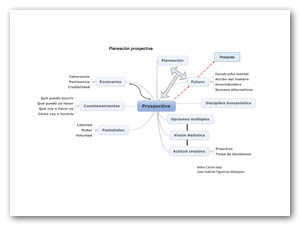
La afirmación fundamental para la planeación es que hay futuros posibles, es así como la prospectiva parte de un principio lógico e indispensable: el futuro aún no existe y se concibe como algo a realizar con opciones múltiples y depende únicamente de la acción del hombre.
El estilo prospectivo de la planeación funciona a la inversa del tradicional, ya que primero determina el futuro deseado y se le diseña creativa y dinámicamente sin considerar pasado y presente, estos los incorpora en la segunda etapa cuando se confronte al futurable.
El futuro que se plantea es un concepto mental y un constructo social de algo que se desea y genera incertidumbre.
La trayectoria de la prospectiva viene del porvenir hacia el presente, rebasando la proyección exclusiva de tendencias, para diseñar y construir alternativas que permitan alcanzar el objetivo deseado. Prepara el camino, guía las acciones presentes y el campo de lo posible del mañana.
Sus propósitos son: generar visiones alternas del futuro, dar impulso a la acción, dar información de largo alcance y relevantes, generar escenarios alternativos y establecer las reglas de decisión para alcanzar el futuro lo mejor posible.
La prospectiva descansa en 3 postulados: el futuro como espacio de libertad, como espacio de poder y como espacio de voluntad. Debe tener una visión holística que permita considerar aspectos cualitativos y cuantitativos de su entorno donde las relaciones son dinámicas, el futuro es múltiple, la actitud es activa y creativa, es decir, es una disciplina con visión global, sistemática, dinámica y abierta que explica los posibles futuros.
Se basa en la estrategia por lo que se deben hacer las siguientes preguntas: ¿Qué puede ocurrir?, ¿Qué puedo hacer yo?, ¿Qué voy a hacer yo? y ¿Cómo voy a hacerlo?
Este proceso tiene como punto máximo el diseño de un escenario probable y de escenarios alternos, que consisten en suponer que se conocen las variables que los integran y diseñar las estrategias indispensables. Un escenario es la imagen del futuro que incluye una descripción de lo que pasaría si llegase a ocurrir lo planteado incluida la incertidumbre, debe regirse bajo 3 condiciones: coherencia, pertinencia y credibilidad.
Palabras clave: Prospectiva, escenarios, futuro
The fundamental statement for planning is that there are possible futures; is how the prospective part of a logical and indispensable principle the future does not exist yet and is seen as something to do with multiple options and depends only on the action of man.
Prospective planning style works the other traditional, as first determines the desirable future and is designed creatively and dynamically without considering past and present, these incorporates the second stage when confronted to futurable.
The future that arises is a mental concept and social construct something you want and creates uncertainty.
The trajectory of foresight into the future is the present, breaking the exclusive screening of trends, to design and build alternatives to achieve the desired objective. Prepare the way; guide the shares present and possible field tomorrow.
Its purposes are: generate alternative visions of the future, give impetus to action, giving information relevant long range, generate alternative scenarios and establish decision rules to achieve the best possible future.
Prospective rests on 3 principles: the future as a space of freedom, such as space power and space will. You must have a holistic vision to consider qualitative and quantitative aspects of their environment where relationships are dynamic, the future is multiple, the attitude is active and creative; it is a discipline with a global vision, systematic, dynamic and open explaining possible futures.
Based on the strategy so you should ask the following questions: What will happen?, what can I do?, what shall I do? and How do I do that?
This process is peak designing a likely scenario and alternate scenarios, which consist in assuming that the variables that comprise the essential strategies and design are known. A stage image of the future that includes a description of what would happen if it were to occur, including the uncertainty raised, should be conducted for 3 principles: coherence, relevance and credibility.
Keywords: Prospective, scenarios, future
MIDEPLAN. (Enero 2005). Prospectiva y construcción de escenarios para el desarrollo territorial. Santiago de Chile.
Miklos, T., y Tello, M. (2007). Planeación prospectiva: una estrategia para el diseño del futuro. Edit. Limusa. México.
[a]Profesora investigadora del ICEA - UAEH
[b]Profesor investigador del ICEA - UAEH